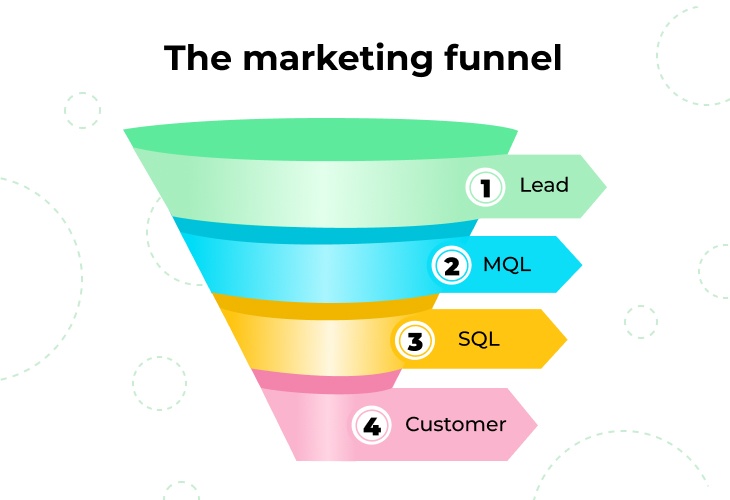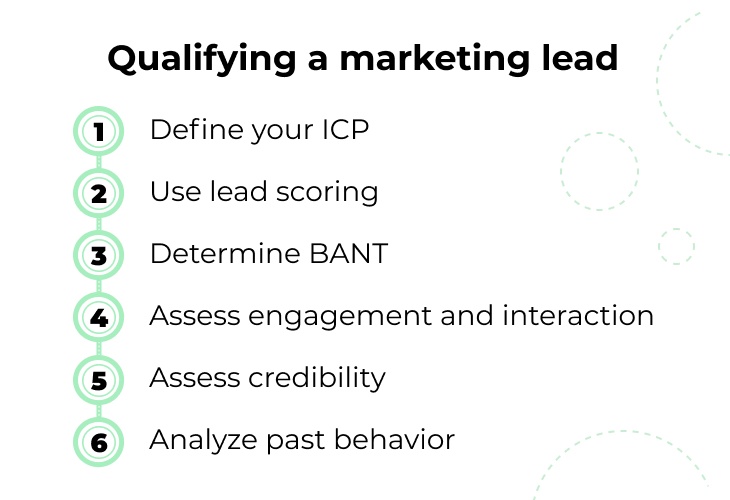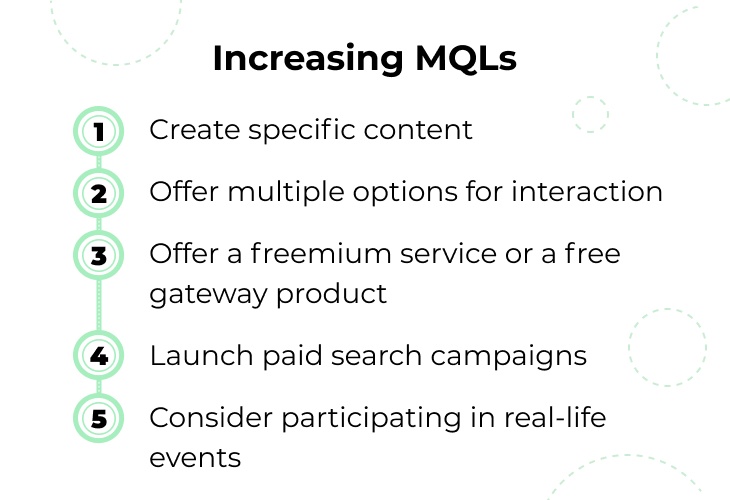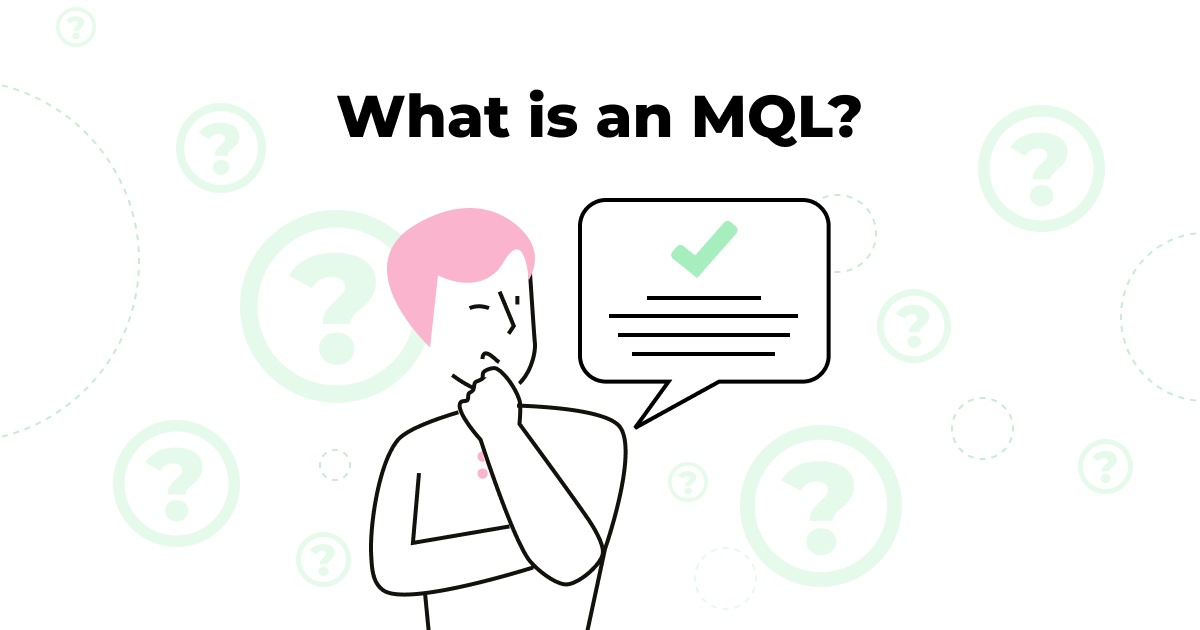To be successful, a business has to determine which customer groups are interested in their products and which are not. Companies will see leads from all sorts of sources, and wasting time chasing those who are unlikely to convert will lower their bottom line. Instead, businesses should focus on generating marketing qualified leads.
What exactly is a marketing qualified lead, and how can understanding this concept boost your overall sales numbers? We’ll explore it in detail throughout this article.
What is a marketing qualified lead?

As mentioned in the introduction, some leads are more interested in your services than others. Maybe they’ve repeatedly visited your site or added an item to the shopping cart online. Or, perhaps, they’ve liked or shared some of the content you post on social media.
These are called “marketing qualified leads”, or, shortly, MQLs. As the name somewhat implies, one marketing qualified lead definition is that it is someone who has responded favorably to your marketing activities.
Another way to think about marketing qualified leads is their position in the marketing funnel:
- Lead
- Marketing qualified lead (MQL)
- Sales qualified lead (SQL)
- Customer
For example, you may have 1,000 different leads. Five hundred of those might interact with your site in some meaningful way. Your marketing team will then assess if those are MQLs. Once they become “sales-ready”, these leads will go to the sales team who will reach out with a customized offer. After those sales conversations, if they go well, they’ll become customers.
How can this concept boost sales?
Businesses often spend too much time chasing leads that are simply uninterested in what they have to offer. For example, cold calling might be easy, but it’s often not the most efficient use of resources. By qualifying and categorizing leads correctly, companies can direct their efforts more efficiently, boosting sales and lowering costs simultaneously.
How to qualify a marketing lead?

Since qualifying a marketing lead is essential to converting the highest-potential leads, the next question is obvious: How do we qualify these leads to determine which are marketing qualified and which are not?
There are multiple ways to qualify leads, and it is beyond the scope of this article to discuss how to qualify them in every single industry and business. That said, most companies can use a general six-step framework.
1. Define your ideal customer profile (ICP)
Hardy Desai, Founder of Supple, suggests developing a buyer persona for your products or services. “It’s a slightly fictional representation of your ideal customers after you’ve done your homework. However, creating this persona takes market research to identify and understand your customers’ demographics, behaviors, motivations, and goals. In the end, this lets you unravel and meet the various needs and wants of different customer segments.”
Whom do you envision as most likely to need and want your company’s products or services?
No matter what your company provides, define the “ideal” customer. Consider characteristics like demographics and the client’s goals and challenges. You can use that profile to do two things: guide marketing efforts, including efficiently allocating resources, and qualify leads based on how closely they match that profile.
2. Use lead scoring
There’s no “one-size-fits-all” solution for scoring. Yet, developing a quantitative metric for how likely a lead is to convert is essential. Consider measures like website visits, emails, calls, job titles, company valuations, etc. You can then funnel these metrics into a classification system to determine the lead conversion likelihood.
At first, these can be simple formulas that give you a rough idea of who will and won’t complete the funnel. As you gather more data, you can refine your approach to develop a more accurate scoring method.
3. Determine a lead’s BANT
The acronym BANT stands for Budget, Authority, Need, and Timeline. Put another way, consider whether your lead’s prospective timeline and whether they have the money, authority, and necessity for your product or service.
For example, if they said they’d buy in a year and you call now, that may be a wasted opportunity. Or, they may be interested but not have the decision-making authority at the company to close the deal. In that case, that particular lead may not be as strong as it initially seems.
By taking some time to consider each lead within the context of BANT, you can prioritize some leads over others.
4. Assess engagement and interaction
A marketing qualified lead will likely engage with your website, social media, email campaigns, and more. Furthermore, that interest will be genuine. They’ll want to visit your site to learn more about your business. By assessing this type of interaction (likely through website analytics platforms), you’ll know how genuine that interest is.
5. Assess the source’s credibility
Some lead sources are more credible than others. If a prospective customer has come to your site and given you their corporate email address in exchange for a free e-book on your company’s specialty, that’s a pretty solid lead. Conversely, if you have Bob891234834 liking your post on Reddit, that’s far less credible. Yes, the interaction is genuine, but an anonymous account has a lower reputation and less credibility than a verified account.
That’s why tracking lead sources is so important. You can prioritize leads from credible sources and focus more tailored efforts on those with a higher reputation.
6. Analyze the lead’s past behavior
Is the lead consistently interacting with your brand, or was this just a one-off thing? Regular engagement history indicates a prolonged interest, making a stronger case to promote it to a marketing qualified lead.
Continuing with the example above, if the person who requested the e-book had this one interaction only, that’s not as strong as, say, if they got the e-book and then followed your Facebook account and started liking your posts.
How to increase marketing qualified leads?

There are typically four strategies that marketers employ to grow the number of MQLs.
1. Create content specifically for marketing qualified leads
The first and typically best strategy is to create content specifically for marketing qualified leads.
Some companies make the mistake of solely creating generic content, but that content falls short of what MQLs expect and want. The content that works best with MQLs includes many case studies, statistics, and facts. It details the gains and benefits of using your product or service.
For example, you might have a claim on your website that your product helps save 20% of time spent on paperwork each week. What might generate more MQLs, though, is if you follow that up with proof, i.e., a case study of a company that saved 22% with your tool. This type of content helps leads build the case to onboard as a client.
Creating factual, statistical content requires interviews and metrics, but it is worth it. These informative articles will push an MQL through the funnel and catch their interest even more.
2. Offer multiple options for interaction
Consider how leads might want communication from your brand and ensure marketing goes through those channels. Some people love to talk to someone, while others prefer to enter their information into a live chat. Capture their preferences, offer multiple options to interact with you, and respect those preferences whenever you reach out. Good marketing software for small business can help you manage all these points of interaction.
3. Offer a freemium service or another free gateway product
This strategy can be a fantastic way to increase MQLs. The trick is to “gate” your free product as a lead magnet (e.g., an e-book), and make it available in exchange for their contact information.
Creating something that people see as valuable enough to enter their email, phone number, name, etc., will help build a collection of motivated, prospective clients. You can cultivate and categorize these leads appropriately by using lead capture software.
4. Launch paid search campaigns
Paid search campaigns can be an excellent way to boost MQLs. Take care, though, to adhere to your budget and not overspend for keywords. There is typically quite a bit of research involved, including some trial-and-error, to locate keywords with the best return-on-investment. Ad platforms offer campaign analytics, helping you spot the most effective phrases for future activities.
5. Consider participating in real-life events
Lastly, don’t underestimate the power of offline events – even if your business offers digital services only. Depending on your industry, there may be trade shows and conferences you can attend. Remember that this is a two-way street. Not only can leads learn more about you, but face-to-face interaction ensures you can learn more about them. As you interact with these prospective customers, qualify them and determine if they are a good fit for your company’s products and services. Talk about warm leads!
Finding and increasing your market qualified leads will boost your sales
It’s not a stretch to say that finding and increasing your marketing qualified leads will help boost your sales. These prospective customers have shown interest in moving through to the next stage of your sales funnel.
At vcita, our platform empowers businesses to grow and thrive. With CRM, scheduling, marketing, and payment platforms, our software helps companies capture leads and accurately designate them as marketing qualified.

























